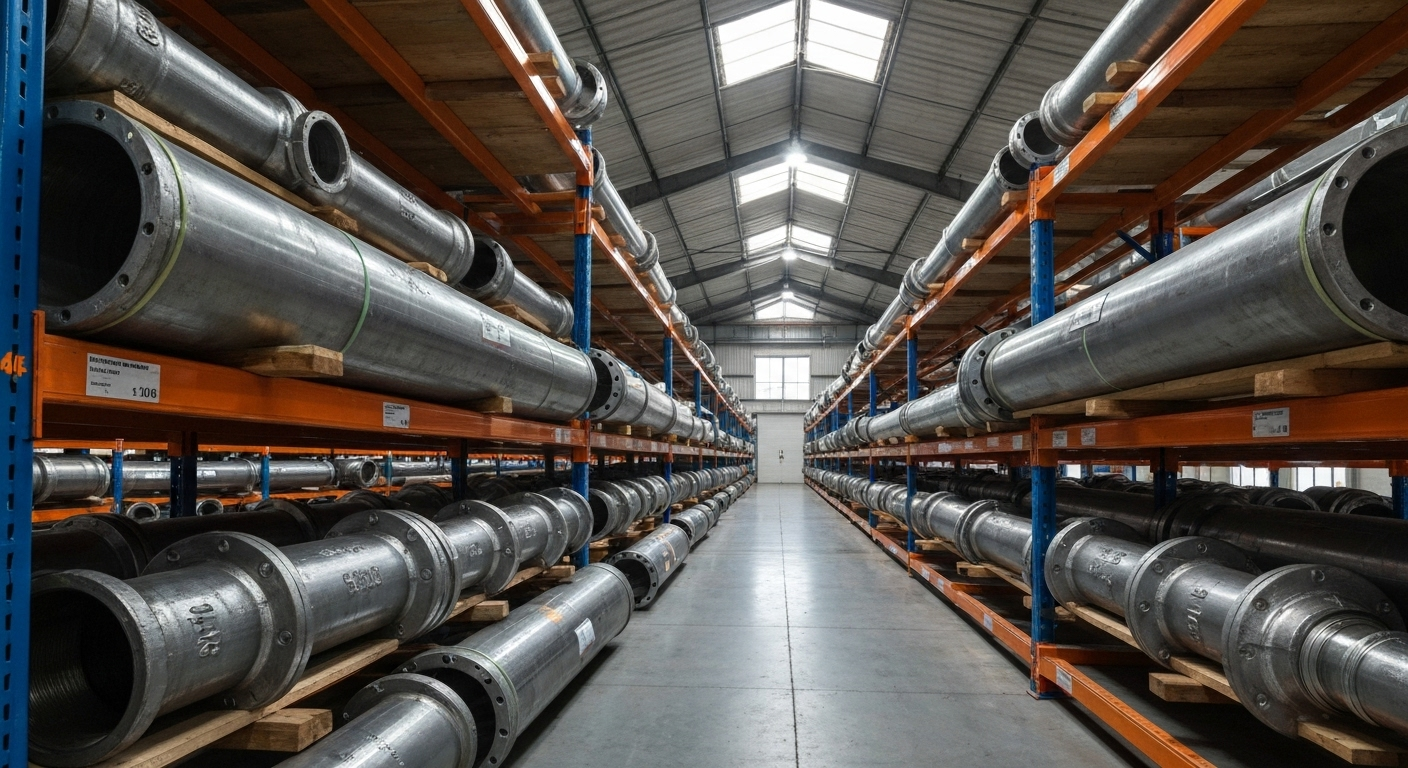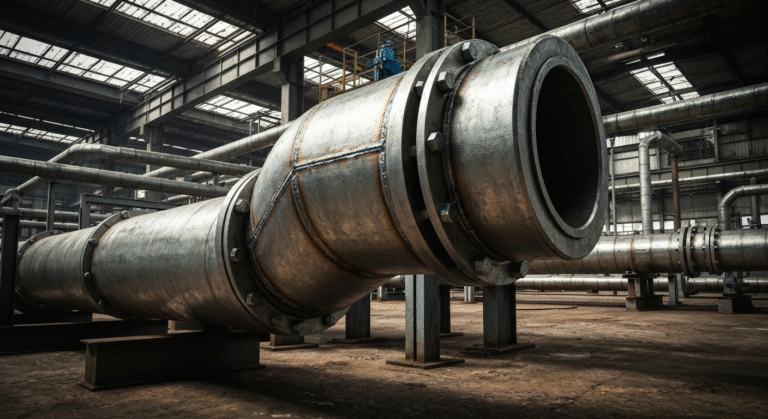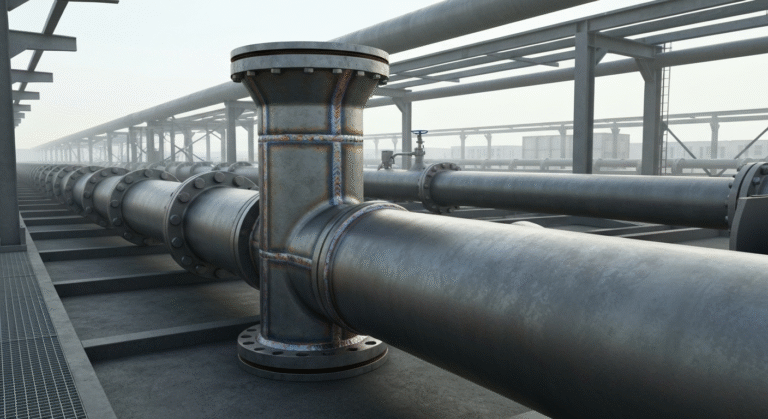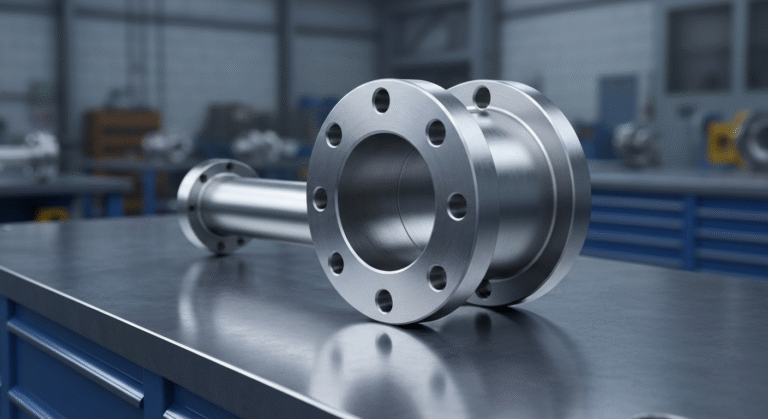-
Промышленная зона Иньчжуан, уезд Мэнцюнь, город Цанчжоу, провинция Хэбэй, Китай

A234 WPB Pipe Fittings: Quality Assurance and Testing

Основные моменты
- ASTM A234 WPB is a standard specification for carbon and alloy steel fittings used in moderate to high-temperature pipeline systems.
- These steel fittings are available in seamless and welded forms, including common types like elbows, tees, and reducers.
- Manufacturing involves processes like forging and shaping to create durable butt weld fittings.
- Strict quality assurance, including inspection and testing, ensures compliance with industry standards.
- Proper documentation and traceability are crucial for verifying the quality of alloy steel fittings.
- The weldability of WPB grade fittings makes them a reliable choice for various industrial applications.
Введение
When you build pipeline systems that are safe and work well, every part must be good quality. The ASTM A234 specification gives a common standard for carbon and alloy steel pipe fittings. These pipe fittings are made for work in moderate and high-temperature settings. You need to know about this specification, so you can be sure the fittings you pick—like the popular WPB grade—are strong enough for your job. This guide will show the checks and tests that help make these fittings a trusted option for pressure piping.
Обзор трубных фитингов ASTM A234 WPB

The ASTM A234 WPB standard is for steel fittings made from carbon and alloy steel. These steel fittings can be seamless or welded. There is an important use for both types in pressure piping and pressure vessel fabrication. These alloy steel fittings are built to work well in places with moderate and high temperatures. The standard helps make sure the fittings can properly change the direction or speed of fluids.
Most of these fittings are made as butt weld fittings. Some common ones are elbows, tees, reducers, and caps. The “WPB” label means the steel is weldable. It also has a set pressure rating. Grade B shows the minimum yield strength of the steel, so you can trust it to do its job. This type of steel is found in many places that use fittings. You can see it a lot because it is strong and works great in this way. Now, let’s look at how people use these fittings and how they are made.
Definition and Main Applications
ASTM A234 WPB is a standard specification for carbon steel pipe fittings. The letters mean different things: “W” says it is weldable, “P” means it is for pressure, and “B” stands for grade B, which tells you about the minimum yield strength of the steel. These fittings are made to work well in moderate to high-temperature settings.
The main use for ASTM A234 WPB fittings is in pipeline systems. You will see them used to connect pipes, change the direction of flow, or adjust how fluids like oil, gas, water, and slurry move through pipes. They are strong, so they work well for these jobs.
ASTM A234 WPB pipe fittings are also used in pressure vessel fabrication. If you need to control fluid movement and keep everything safe at high temperatures, these fittings are a good choice. They always meet strict safety and performance rules.
Common Materials and Manufacturing Processes
The raw materials used for A234 WPB steel fittings include killed steel, plates, bars, and pipes that are either seamless or made by fusion-welding. For the WPB grade, the material often has a carbon level that goes up to 0.35%. Important elements, like manganese, must be controlled closely. When the carbon goes down by 0.01%, the manganese can go up by 0.06%, but not above 1.35%.
Other elements such as copper, nickel, niobium, and molybdenum are part of the mix too, but these need to stay within limits to keep the properties right. The total of these added elements cannot be more than 1.00%. This lets the fittings keep their needed qualities. Some alloy steel fittings that follow the A234 standard might have more chrome and molybdenum to do better in use.
To make these fittings, the process includes steps such as forging, pressing, piercing, extruding, bending, and fusion welding. These different ways of forging and shaping help turn the raw material into the finished fitting. After making the fittings, cooling them the right way is needed so they don’t have flaws and they get the right strength and features.
Key Specifications and Industry Standards
To keep things safe and uniform, A234 WPB pipe fittings must follow many rules and standards. ASTM A234 provides the main set of guidelines for the materials, how to make them, and how to test them. This standard joins with others that set the size and tolerance rules.
Common standards for fittings include ASME B16.9 for buttweld fittings and ASME B16.11, which focuses on forged fittings. Groups like ANSI and ASME help make the rules that manufacturers use. These rules make sure fittings are safe and work well with all the other parts. In the next sections, it will cover what each property must meet and talk about how to follow these rules.
Chemical and Mechanical Property Requirements
The chemical composition of ASTM A234 WPB fittings is tightly controlled to ensure proper performance. For WPB grade, the carbon content is capped at 0.30%, while manganese ranges from 0.29% to 1.06%. Other elements like phosphorus and sulfur have strict maximum limits. The combined content of copper, nickel, chromium, and molybdenum must not exceed 1.00%, which is crucial for maintaining weldability and strength.
Beyond chemistry, the mechanical properties are what guarantee the fitting can withstand operational stresses. A234 WPB fittings must meet minimum tensile and yield strength requirements, which vary depending on the specific grade and material thickness. These properties ensure the fitting will not fail under pressure.
For example, Grade WPB must have a minimum yield strength of 240 MPa (35,000 psi) and a tensile strength between 415 and 655 MPa (60,000-95,000 psi). Hardness is also tested to ensure it falls within acceptable limits, preventing the material from being too brittle.
Недвижимость | WPB Grade Requirement |
|---|---|
Tensile Strength, range | 415-655 MPa [60-95 ksi] |
Yield Strength, min | 240 MPa [35 ksi] |
Carbon (C), max | 0.30% |
Manganese (Mn) | 0.29-1.06% |
Phosphorus (P), max | 0.050% |
Sulfur (S), max | 0.058% |
Silicon (Si), min | 0.10% |
Certification and Compliance Considerations
When you buy A234 WPB pipe fittings, it is important to check the certification and compliance. Every pipe fitting should have papers that show it meets the ASTM A234 specification. This is how you can be sure the fittings have been made and checked the right way.
The fittings must also follow the size standards set by groups like ASME and ANSI. For example, buttweld fittings have to match the ASME B16.9 standard. This rule is about the size, markings, and how close things need to fit. It helps make sure pipe fittings work with each other and fit well when you put them in. This is needed for the piping system to be strong and safe.
Checking certification and compliance helps make sure each fitting is safe, works well, and does the job it should. Before using your new fittings, always ask for and look at the Material Test Report (MTR) and any other needed paperwork. This will help you know your pipe fittings meet every rule you need.
Types of A234 WPB Pipe Fittings Available
The ASTM A234 WPB standard is for pipe fittings you need in building all types of pipeline systems. These buttweld fittings are made to be welded right onto the pipes. This gives a strong, leak-proof connection every time. With so many types to choose from, you can do a lot: change the flow direction, branch out a line, or make the pipe smaller where you need to.
Some common fittings are the 90-degree bend and 45-degree bend. You use these bends when you want to change which way something flows in the pipes. The tee helps you branch off from the main pipe. The reducer is there when you need to move from one pipe size to another. You also have caps, and they are used to close off the end of a pipe. Now, let’s get into these different fitting types and see how they measure up to other fittings you might use in pipeline systems.
Butt-Weld, Socket Weld, and Other Fitting Types
The most common fitting used in the A234 standard is the butt weld fitting. These fittings are made with ends cut at an angle from stainless steel. When you line them up with a pipe, they help form a funnel shape for a strong weld that goes all the way through. This way makes sure the inner surface is smooth, so there is less drop in pressure and less swirling inside the pipe.
On the other hand, socket weld fittings have a space, or socket, where you put the pipe in before welding the outside with a fillet weld. These are easier to line up, but can leave a small gap inside. That gap can sometimes cause rust in certain cases. You can get both butt weld fittings and socket weld fittings in a mix of sizes and sch to match the pipe’s diameter and wall thickness.
Here is a quick comparison of common fitting types:
- Butt Weld Fittings: Give a strong, full weld. They work well for high-pressure and high-heat setups.
- Socket Weld Fittings: Easier to put in but usually used for smaller pipes where the pressure is lower.
- Threaded Fittings: These are screwed together and are good for low-pressure spots where welding might not work.
Comparison with Other Carbon Steel Fittings
Within the ASTM A234 specification, the most common carbon steel grade is WPB. But it is not the only one. Another type is WPC, which has a higher limit for carbon. WPC allows up to 0.35% carbon, while WPB is at 0.30%. This small change in carbon amount can affect things like how well the steel fittings can be welded and how strong they are.
The main way WPB is different from other carbon steel grades is in the set limits for manganese, silicon, copper, and some other alloys. WPB fittings have a good balance. They are strong and can be welded easily. That makes them useful for many jobs with both high and moderate heat.
When you look at alloy steel fittings, some like WP5 or WP9, that also fall under the A234 standard, the changes are much bigger. These alloy steel fittings have more chromium and molybdenum. Those parts give them extra strength and better protection against rust and damage. That is why alloy grades work well in places that are tough and where things might corrode.
You should pick between WPB, WPC, or alloy steel fittings based on what your system needs. The right choice comes down to the system’s pressure, the temperature, and what is flowing through it.
Quality Assurance Measures in A234 WPB Fittings

Making sure A234 WPB fittings are good starts with a strong quality check system. This begins by getting the right certified raw materials. The process covers every step of making the fittings. Careful checks and tests are done to see that each part matches the strict chemical and mechanical rules the ASTM standard asks for.
Some important steps for quality include complete checking, full traceability, and keeping good records. All these help make certain that each fitting has no faults and meets every standard. So you know it works well. Next, we will look at these quality control steps for fittings and ASTM WPB in more detail.
Inspection Protocols and Quality Control Steps
A strong inspection routine is very important for making sure A234 WPB fittings are good quality. First, the people in charge check the raw materials to see if they have the right chemical makeup and to make sure there are no problems with them. During manufacturing, and especially after forming steps like forging, each fitting is checked by looking at it and measuring it.
The main purpose of these checks is to find and remove any problems or mistakes, like if something is wrong with the weld. Each fitting must meet the size standards set by rules like ASME B16.9. This helps make sure the fitting goes in right and the pipeline stays strong.
Key inspection and quality checks for fittings include:
- Visual Inspection: Looking for problems on the surface, cracks, or anything else that should not be there.
- Dimensional Checks: Making sure the diameter, wall thickness, and bevel angle are correct.
- Material Verification: Testing or reviewing documents to confirm the grade and what the fitting is made of.
- Marking and Stamping Review: Checking that all needed information is marked for rules and tracking.
These checks are needed to make sure wpb fittings work the way they should with each use. The right thickness and diameter are important, and checking them to fit ASME standards helps avoid trouble and keeps everything working well.
Traceability and Documentation Practices
Traceability is a key part of making sure fittings like A234 WPB fittings meet high standards. It helps you track each fitting from when it is put in all the way back to the raw stuff it was made from. Most of the time, each part has a unique heat number or a special code stamped or marked on it.
This is very important for control and knowing who is responsible. If there is ever a problem with the fitting, you can track down the whole batch, find out what went wrong, and fix it. Without this, it would be hard to know where the fitting came from or if it has good quality.
Having the right papers is also important to prove this tracking and to show the fittings follow all the rules. Things like a Material Test Report (MTR) go with each fitting. These documents give details about the stuff used to make it, test results, and a note that it passes the ASTM A234 specification. These papers are your proof that the product meets every standard it should.
Testing Procedures for A234 WPB Pipe Fittings
To check if A234 WPB fittings are good, makers do many tests. The steps they use help to make sure the metal is strong and matches what is needed by the specification, and that each fitting does not have any hidden problems. This is very important when the part will be used in pressure piping, where it faces a lot of stress.
The testing has two main parts. Some tests look at mechanical things like how much strength the material has and how hard it is. Other tests, called non-destructive testing (NDT), look for problems inside without breaking the fitting. These steps give the last check on if each fitting can be used.
Now, let’s talk about the ways these tests are done and what a fitting must show to pass and be used in pressure piping systems.
Mechanical and Non-Destructive Testing Methods
Mechanical testing is done on samples from every production batch. This checks that the material in the fittings meets the needed properties for pressure piping systems. These tests break the fitting to see if it has enough strength and flexibility. The results are checked against the minimum limits in the ASTM A234 specification.
Apart from these tests, there can be non-destructive testing (NDT) to look for hidden defects in the fittings. NDT uses things like magnetic particle, liquid penetrant, or radiographic methods. These help find cracks or holes that you can’t see by just looking at the fitting. It is very important for welded fittings because you want to make sure the fusion is solid.
Common ways to test include:
- Tensile Test: Checks the highest strength the material can take before breaking and the point where it starts to stretch.
- Hardness Test: Makes sure the fitting is not too hard or brittle, so it will not break easily. Testing is usually done on at least two pieces from every batch.
- Hydrostatic Test: Makes sure the fitting can handle the needed inside pressure without leaking or giving way.
- Non-Destructive Testing (NDT): Finds problems in and under the surface without hurting the part.
So, these tests help confirm that all fittings for pressure piping follow the ASTM specification and are safe to use. This makes sure their fusion and strength are good for the job.
Acceptance Criteria and Test Reporting
After the testing is done, the results are checked with the acceptance criteria. These rules are set by the ASTM A234 specification and other standards. For fittings to be passed, their chemical and mechanical features must be in the right critical range and other specified ranges. If any fitting from a group does not match these rules, it does not pass.
All the results from the tests are put together in a formal document called a Material Test Report (MTR) or test report. This record is a big part of quality assurance. It is kept as proof of the properties of the fittings and shows that they meet the needed specification.
When you get A234 WPB fittings, it’s important to ask for and look at the MTR. This report should show the right material grade, the chemical analysis, details about the mechanical test results such as tensile and yield strength, and say that the fittings are made as per the ASTM A234 standard. This is a key step to help make sure it is safe and good quality.
Welding Suitability and Performance Characteristics
The “W” in WPB shows that these fittings can be welded. This is an important part of how they work. Their makeup is made to help with weldability. It means you can join them strongly to your pipes. This helps build pipeline systems that do not leak when you use normal welding methods.
To get good welding results, you need to choose the right filler metal. You also need to use steps that are known to work well. These steps help you get full fusion without making mistakes. If you put in A234 WPB fittings the right way, they work well in the industrial fields where you need them.
The next parts will talk about the things that can change weldability. Also, the next sections cover how they perform for different industries.
Weldability Factors for A234 WPB Pipe Fittings
The good weldability of A234 WPB pipe fittings comes from their controlled chemical makeup. Limits on carbon and other parts help to stop cracking when you weld and cool the metal. Thanks to this careful mix, welding is easy on pipe fittings with normal thickness. Sometimes, if the fittings are thicker, this could change and may need more care.
To get a strong weld, you need more than just a good fitting. You must get the joint ready. Clean the ends and bevel them for the best fusion. Pick the right filler metal. It has to match the base part. Then the weld can be as strong as the pipe and fittings.
You should also control how you weld. Things like the heat you use and how fast you move can change how strong the weld is. When fittings with a wall thickness of 3/4 inch or more are welded by fusion, you must usually do a heat treatment after welding. This helps to release any stress left in the pipe fittings. It makes sure the fittings and weld will work well.
Performance Across Different Industrial Sectors
ASTM A234 WPB pipe fittings are known for their solid performance. You will see them used in a lot of industrial areas. These fittings work well when the temperature and pressure levels are not low. That is why people in the oil and gas industry use them for pipeline systems in many stages, including upstream, midstream, and downstream.
In power plants, these pipe fittings help build the steam and water piping. This is true for both fossil fuel and nuclear power plants. Their steady performance makes these places safe and helps everything work the way it should. You also find pipe fittings joined with valves and other tools. These connections guide the flow in complex systems.
Many other places use A234 WPB fittings too. Chemical plants, water treatment centers, and manufacturing companies pick them for different jobs. If there is the need to move liquids safely through pipeline systems with pressure, these fittings give you a cost-saving and lasting answer. They help create strong networks that get the job done right.
Заключение
A234 WPB pipe fittings are important for many industries. They help keep things safe and running well in different jobs. It is good to know about the rules, quality checks, and tests before you use or pick these pipe fittings. When you follow the right steps and use strong quality control, you can trust in the work and life of these fittings.
If you are looking for fittings for building or for making things, picking good A234 WPB fittings can really help your project come out well. If you want to buy A234 WPB pipe fittings, look for trusted suppliers. Make sure they can give you papers that show their pipe fittings are safe and meet the needed rules. This helps you get what you need and keeps your work on track.
Часто задаваемые вопросы
What industries most commonly use A234 WPB pipe fittings?
ASTM A234 WPB fittings be used a lot in pipeline systems and other types of pressure piping. You can find them in oil and gas mainly, as well as power plants and chemical plants. They have to work well when the heat is up and work for a long time. That is why they get picked for the job in these places.
How do I verify the certification and quality of A234 WPB fittings?
To check quality, you should always ask for the Material Test Report (MTR) or paperwork that shows certification when you buy something. This report lets you know that it meets the ASTM A234 specification. It gives details about the chemical analysis and the results of mechanical tests. This is an important step for good quality assurance.
Are A234 WPB pipe fittings available for online purchase in the United States?
Yes, you can find ASTM A234 WPB steel fittings from many industrial suppliers all over the United States. A lot of these places let you buy fittings on their websites. This makes it easy to get the steel fittings and other fittings you need that match your project’s astm wpb specification, right from the internet.
What is a concentric reducer?
A concentric reducer is a type of pipe fitting that connects two pipes of different diameters while maintaining a symmetrical profile. This fitting allows for a smooth transition between sizes, ensuring consistent fluid flow and pressure throughout the system, making it essential in various piping applications.


